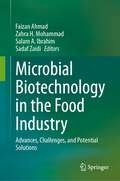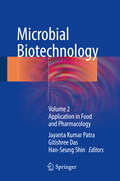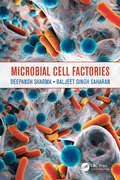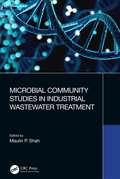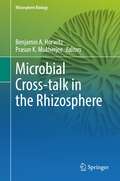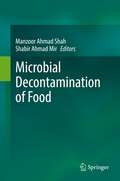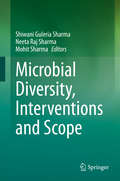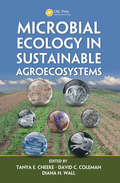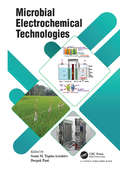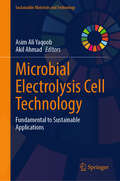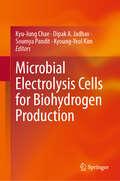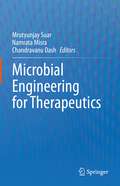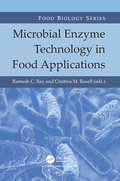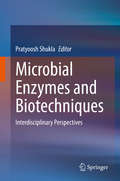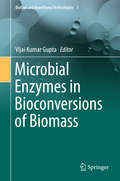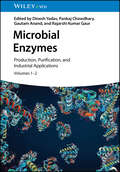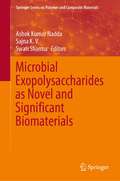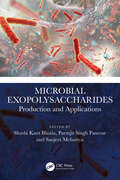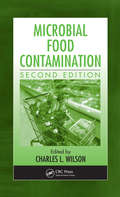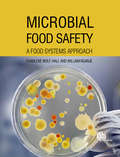- Table View
- List View
Microbial Biotechnology in the Food Industry: Advances, Challenges, and Potential Solutions
by Salam A. Ibrahim Faizan Ahmad Zahra H. Mohammad Sadaf ZaidiBiotechnology is a promising emerging technology that uses biological systems to develop new products with broad application across medical, industrial and environmental fields. Biotechnology in the food industry provides solutions to microbial issues as well as broader environmental issues, making it key to the safe and environmentally conscious production of all food types. Microbial Biotechnology in the Food Industry focuses on the major microbial issues facing the food industry and solutions using novel biotechnology techniques. The text promotes an understanding of basic and advanced microbiological issues in food production including food products, food contact surfaces, food operation floor and air and a wide range of issues related specific solutions using biotechnology. This text provides researchers and those in the food industry with a full overview of current innovative solutions to the major microbial issues in the food industry utilizing biotechnology.
Microbial Biotechnology: Basic Research and Applications (Environmental and Microbial Biotechnology #1)
by Ram Prasad Shanquan Wang Joginder Singh Ashish VyasMicrobial biotechnology is an important area that promotes advanced research into using microbes for value-added products, human nutrition, and the overall wellbeing of society. This book presents the latest information on the use of microbes for sustainable development, and highlights state-of-the-art biotechnological techniques used to harness microbial biotechnological traits on a commercial scale. Gathering contributions from authoritative researchers in the field, it addresses recent advances in microbial biotechnological approaches that offer sustainable options for future generations. Exploring a broad range of microbial products and their uses, the book specifically places emphasis on the application of microorganisms in healthcare, the environment and industry. It also discusses various compound classes derived from microbial metabolites. Pursuing a holistic approach to recent advances in the utilization of various microbes as biotechnological tools, the book also covers traditional uses, and explores emerging strategies to harness their full potential. Accordingly, it offers a valuable resource for researchers and graduate students alike.
Microbial Biotechnology: Progress and Trends
by Farshad Darvishi Harzevili Hongzhang ChenIncorporates the Experiences of World-Class Researchers Microbial Biotechnology: Progress and Trends offers a theoretical take on topics that relate to microbial biotechnology. The text uses the "novel experimental experiences" of various contributors from around the world—designed as case studies—to highlight relevant topics, issues, and recent developments surrounding this highly interdisciplinary field. It factors in metagenomics and microbial biofuels production, and incorporates major contributions from a wide range of disciplines that include microbiology, biochemistry, genetics, molecular biology, chemistry, biochemical engineering, and bioprocess engineering. In addition, it also provides a variety of photos, diagrams, and tables to help illustrate the material.The book consists of 15 chapters and contains subject matter that addresses: Microbial biotechnology from its historical roots to its different processes Some of the new developments in upstream processes Solid-state fermentation as an interesting field in modern fermentation processes Recent developments in the production of valuable microbial products such as biofuels, organic acids, amino acids, probiotics, healthcare products, and edible biomass Important microbial activities such as biofertilizer, biocontrol, biodegradation, and bioremediation Students, scientists, and researchers can benefit from Microbial Biotechnology: Progress and Trends, a resource that addresses biotechnology, applied microbiology, bioprocess/fermentation technology, healthcare/pharmaceutical products, food innovations/food processing, plant agriculture/crop improvement, energy and environment management, and all disciplines related to microbial biotechnology.
Microbial Biotechnology: Volume 2. Application in Food and Pharmacology
by Jayanta Kumar Patra Gitishree Das Han-Seung ShinThis edited book, is a collection of 25 chapters describing the recent advancements in the application of microbial technology in the food and pharmacology sector. The main focus of this book is application of microbes, food preservation techniques utilizing microbes, probiotics, seaweeds, algae, enzymatic abatement of urethane in fermentation of beverages, bioethanol production, pesticides, probiotic biosurfactants, drought tolerance, synthesis of application of oncolytic viruses in cancer treatment, microbe based metallic nanoparticles, agro chemicals, endophytes, metabolites, antibiotics etc. This book highlighted the significant aspects of the vast subject area of microbial biotechnology and their potential applications in food and pharmacology with various topics from eminent experts around the World. This book would serve as an excellent reference book for researchers and students in the Food Science, Food Biotechnology, Microbiology and Pharmaceutical fields.
Microbial Cell Factories
by Deepansh Sharma and Baljeet Singh SaharanMicrobial Cell Factories is a conceptual, reference-based source including chapters covering microbial cell factories for industrial developments, microbial biotechnology, sustainable environmental solutions, agriculture practices, microorganisms in food processing, metabolites as next generation food additives/food processing, and microbial cell factories in alternative energy fuel generation. The book highlights trends and developments in the field of microbial products, written by an international team of leading academic and research scholars. Key Selling Features: Highlights trends and developments in microbial biotechnology Systematically reviews microbial cell factories Explores the potential of microbial cell derived industrial production Synthesizes information on environmental and agricultural uses of microbial biotechnology Contributions from an international team of leading scholars
Microbial Community Studies in Industrial Wastewater Treatment
by Maulin P. ShahFocusing on microbial community structure in the field of wastewater treatment, this book highlights structural analyses in relation to changes in physico-chemical parameters. It further covers physiological analyses of microbial communities, enrichment of pure cultures of key species in relation to changes in physico-chemical parameters, and analyses and modelling of consequences of changes in microbial community structure. Based on 16S rRNA gene sequencing, groups of bacteria that perform nitrogen fixation, nitrification, ammonification and other biochemical processes are covered for an entire wastewater treatment plant bioreactor along with temporal dynamics of bacterial communities. Features: Describes the state-of-the-art techniques and the application of omics tools in wastewater treatment reactors (WWTRs). Includes both the theoretical and practical knowledge on the fundamental roles of microorganisms in WWTRs. Discusses environmental microbial community proteomics. Covers relating function and community structure of complex microbial systems using neural networks. Reviews the economics of wastewater treatment and the development of suitable alternatives in terms of performance and cost-effectiveness. This book is aimed at graduates and researchers in biological engineering, biochemical engineering, chemistry, environmental engineering, environmental microbiology, systems ecology and environmental biotechnology.
Microbial Cross-talk in the Rhizosphere (Rhizosphere Biology)
by Prasun K. Mukherjee Benjamin A. HorwitzThis book discusses the cross-talk between plants and microbes in the rhizosphere. The rhizosphere is the hotspot of microbial activities that influence plant growth and crop yield. The rhizosphere-residing microbes include the nitrogen-fixing rhizobia, mycorrhizal fungi, antibiotic-producing bacteria, antagonistic, plant-beneficial fungi, and entomopathogens. The three-way cross-talk among the plants, the pathogens and other microbes involves signaling molecules, metabolites, and physical interactions. The book also describes deleterious and beneficial aspects of this communication between plants and microbes. Plants program the local microbiome near their roots, and the microbial community has a profound influence on the functioning of the plant. This complex communication makes the collection of chapters a timely one, because the diverse subjects are linked by their focus on the molecular language of plant-microbe cross-talk.This timely and informative book is useful for students and researchers in the fields of microbiology, soil biology, and plant pathology.
Microbial Decontamination of Food
by Manzoor Ahmad Shah Shabir Ahmad MirFood is contaminated in the production chain and is the point of concern among the consumers and industries. There is also a considerable increase in foodborne outbreaks, which possess the challenge to industry associated with the production of processed food. Various strategies are used to prevent the contamination during postharvest stage, storage and distribution. Different methods are exploited for degrading or eliminating the microbial contamination from food commodities. The conventional techniques used for decontamination demanded a considerable requirement for novel technologies, which are efficient, environmental friendly, and cost-effective. Novel technologies efficiently remove the contamination without adversely affecting the nutritional properties and sensory characteristics of food material. There is a lack of scientific information on the microbial decontamination of different food commodities such as fruits, vegetables, cereals, sprouts, microgreens, meat, poultry, milk, nut, spices etc. under one umbrella. The application of conventional and novel technologies for improving the food safety of individual food commodities will be addresses in this book. Written by several experts in the field, this book is a valuable source for students, scientists, and professionals in food science, food microbiology, food technology, food processing, and other allied sciences.
Microbial Diversity, Interventions and Scope
by Neeta Raj Sharma Shiwani Guleria Sharma Mohit SharmaThis book focuses on the application of microbes in all fields of biology. There is an urgent need to understand and explore new microbes, their biological activities, genetic makeup and further opportunities for utilizing them. The book is divided into sections, highlighting the application of microbes in agriculture, nanotechnology, genetic engineering, bioremediation, industry, medicine and forensic sciences, and describing potential future advances in these fields. It also explores the potential role of microbes in space and how they might support life on a different planet.
Microbial Ecology in Sustainable Agroecosystems (Advances in Agroecology)
by David C. Coleman Diana H. Wall Tanya E. CheekeWhile soil ecologists continue to be on the forefront of research on biodiversity and ecosystem function, there are few interdisciplinary studies that incorporate ecological knowledge into sustainable land management practices. Conventional, high fossil-fuel input-based agricultural systems can reduce soil biodiversity, alter soil community structu
Microbial Electrochemical Technologies
by Deepak Pant Sonia Tiquia-ArashiroThis book encompasses the most updated and recent account of research and implementation of Microbial Electrochemical Technologies (METs) from pioneers and experienced researchers in the field who have been working on the interface between electrochemistry and microbiology/biotechnology for many years. It provides a holistic view of the METs, detailing the functional mechanisms, operational configurations, influencing factors governing the reaction process and integration strategies. The book not only provides historical perspectives of the technology and its evolution over the years but also the most recent examples of up-scaling and near future commercialization, making it a must-read for researchers, students, industry practitioners and science enthusiasts. Key Features: Introduces novel technologies that can impact the future infrastructure at the water-energy nexus. Outlines methodologies development and application of microbial electrochemical technologies and details out the illustrations of microbial and electrochemical concepts. Reviews applications across a wide variety of scales, from power generation in the laboratory to approaches. Discusses techniques such as molecular biology and mathematical modeling; the future development of this promising technology; and the role of the system components for the implementation of bioelectrochemical technologies for practical utility. Explores key challenges for implementing these systems and compares them to similar renewable energy technologies, including their efficiency, scalability, system lifetimes, and reliability.
Microbial Electrochemical Technologies: Fundamentals and Applications
by Rao Y. Surampalli Tian C. Zhang Makarand M. Ghangrekar Narcis M. DuteanuA one-stop guide to the future of sustainable energy production The search for sustainable energy sources powered by renewable, non-fossil fuel resources is one of the great scientific challenges of the era. Microorganisms such as bacteria and algae have been shown to function as the basis of a microbial fuel cell, which can operate independently of an electrical power grid on the basis of renewable feed sources. These fuel cells have shown applications ranging from powering implantable biomedical devices to purifying rural water sources, and many more. Microbial Electrochemical Technologies offers a one-stop shop for researchers and developers of technologies incorporating these microbial fuel cells. Beginning with the fundamental processes involved in microbial energy production and the key components of a bioelectrochemical system (BES), it then surveys the major BES types and crucial aspects of technological development and commercialization. The result is an indispensable introduction to these vital power sources and their myriad applications. Microbial Electrochemical Technologies readers will also find: Detailed treatment of BES types including fuel cells, electrolysis and electrosynthesis cells, and more Discussion of commercialization aspects including modelling, performance analysis, and life cycle assessment An authorial team with decades of combined experience on three continentsMicrobial Electrochemical Technologies is a useful reference for electrochemists, microbiologists, biotechnologists, and bioengineers.
Microbial Electrolysis Cell Technology: Fundamental to Sustainable Applications (Sustainable Materials and Technology)
by Akil Ahmad Asim Ali YaqoobThis book covers the different aspects of microbial electrolysis cell (MEC) technology and its applications in wastewater treatment such as nutrient recovery and heavy metals removal. The MEC technique is related to the technique the microbial fuel cells (MFC);, while the MFC uses the microbial decomposition of organic molecules to generate an electric current, MEC partly reverses the process by using an electric current to generate hydrogen or methane from organic material. If a sustainable energy source is used to generate the electric current, the generated hydrogen or methane can be used in an internal combustion engine or PEM fuel cell to generate energy. The chapters in this book describe the basic principles and working mechanism of the MEC, its effectiveness depending on the kind of microorganisms present, type of electrode materials, use of catalysis, and lastly its potential industrial applications for environmental remediation. This book benefits students, young researchers, academicians, and industrial scientists who are working in the field of environmental pollutants and their safe removal using new technologies.
Microbial Electrolysis Cells for Biohydrogen Production
by Soumya Pandit Kyu-Jung Chae Dipak A. Jadhav Kyoung-Yeol KimThis book covers microbial electrolysis cells (MEC) for biohydrogen production and explores the basics, challenges, limitations and applications of this technology. The latest advances in electrochemical reactors and microbial electrochemical systems are also presented, accompanied by a discussion on the way forward towards practical use of MEC technology. Divided into 3 parts, the book commences with an introduction to the fundamentals of microbial electrolysis cells and biohydrogen production, followed by an overview of the latest advances in microbial electrolysis cell research, with particular attention given to the performance and operating conditions. The third part of this book is devoted to MEC scaling-up, were readers will find the recent progresses in the field. The possibilities and challenges of integrating conventional wastewater treatment systems with MEC, commercialization challenges of MECs, and life cycle assessment of MEC for biohydrogen production are alsodiscussed in this part of the book. In this book, readers will also find useful case studies detailing pilot-scale applications of MEC for industrial wastewater treatment. Given its breadth, this book is a valuable resource for scholars in the energy domain, policymakers and researchers actively working with MEC applications. Furthermore, it also appeals to early-stage researchers and scientists interested in the dynamics of microbial electrolysis for wastewater treatment, biohydrogen generation and resource recovery from wastewater.
Microbial Engineering for Therapeutics
by Mrutyunjay Suar Namrata Misra Chandravanu DashThis book highlights the recent advances in the field of microbial engineering and its application in human healthcare. It underscores the systemic and synthetic biology approaches for engineering microbes and discusses novel treatments for inflammatory bowel diseases based on engineered probiotics. The book also reviews the different options and methods for engineering microbes, ranging from recombinant DNA technology to designing microbes for targeting specific sites and delivering therapeutics. Further, it discusses genetically engineered microorganisms for smart diagnostics and describes current approaches in microbial gene editing using CRISPR-Cas9-based tools. Lastly, it summarizes the potential applications of human microbiome engineering in improving human health and explores potential strategies for scaling-up the production of engineered microbial strains for commercial purposes, as well as the challenges. Given its scope, this book is a valuable resource for students, researchers, academics and entrepreneurs interested in understanding microbial engineering for the production of commercial products.
Microbial Enhanced Oil Recovery: Principles and Potential (Green Energy and Technology)
by Pankaj Tiwari Lalit PandeyThis book presents the fundamentals of the reservoir and interfacial engineering. The book systematically starts with the basics of primary, secondary and tertiary (enhanced) oil recovery and emphasizes on the theory of microbial-enhanced oil recovery (MEOR) and its potential toward recovery of oil in place. Different approaches of MEOR such as in-situ, ex-situ, and integration of chemical- and microbial-enhanced oil recovery (EOR) are discussed in detail. This book highlights the link between the effectiveness of MEOR and the local reservoir conditions, crude oil characteristics, and indigenous microbial community. The latest implementations of MEOR across the globe are highlighted as case studies to outline the potential as well as the scope of MEOR. Given the topics covered, this book will be useful for professionals and researchers working in the areas of petroleum science and engineering, chemical engineering, biotechnology, bioengineering, and other related fields.
Microbial Enzyme Technology in Food Applications (Food Biology Series)
by Ramesh C. Ray and Cristina M. RosellThe aim of food processing is to produce food that is palatable and tastes good, extend its shelf-life, increase the variety, and maintain the nutritional and healthcare quality of food. To achieve favorable processing conditions and for the safety of the food to be consumed, use of food grade microbial enzymes or microbes (being the natural biocatalysts) is imperative. This book discusses the uses of enzymes in conventional and non-conventional food and beverage processing as well as in dairy processing, brewing, bakery and wine making. Apart from conventional uses, the development of bioprocessing tools and techniques have significantly expanded the potential for extensive application of enzymes such as in production of bioactive peptides, oligosaccharides and lipids, flavor and colorants. Some of these developments include extended use of the biocatalysts (as immobilized/encapsulated enzymes), microbes (both natural and genetically modified) as sources for bulk enzymes, solid state fermentation technology for enzyme production. Extremophiles and marine microorganisms are another source of food grade enzymes. The book throws light on potential applications of microbial enzymes to expand the base of food processing industries.
Microbial Enzymes and Biotechniques: Interdisciplinary Perspectives
by Pratyoosh ShuklaThis book compiles the latest research on the multifarious roles of microbial enzymes, and provides an overview of microbial enzymes and biotechnologies. It discusses the use of microbial enzymes in innovative areas like nanomedicine and synthetic biotechnology, as well as the use of starch digesting enzymes and bioactive proteins as biotherapeutics, all of which have applications in modern drug discovery processes. The book also examines the concept of microbial biotransformation and protein engineering, and covers topics such as the immobilization of therapeutic enzymes, bioengineering of enzymes for bioactive compounds, the production of hydrolytic and oxidative enzymes from plant raw materials, and prebiotics and probiotics.Given its multidisciplinary scope, this book will appeal to researchers and industry experts in the fields of microbiology, biotechnology and molecular medicine.
Microbial Enzymes in Bioconversions of Biomass
by Vijai Kumar GuptaThis volume summarizes our current knowledge on different biomass-converting enzymes and their potential use in converting biomass into simple sugar to generate bioenergy and other value added co-/by products. It consists of 13 chapters and is divided into three parts: cellulases; hemicellulases; and lignocellulose oxidoreductases. Written by international experts, the contributions offer clear and concise descriptions of both standard and new technologies. It is an invaluable reference resource for undergraduates, post-graduates, researchers and practitioners in the field of microbial enzymes for biofuel and biorefinery applications.
Microbial Enzymes: Production, Purification, and Industrial Applications, 2 Volume Set
by Rajarshi Kumar Gaur Pankaj Chowdhary Gautam Anand Dinesh YadavComprehensive discussion of production and purification strategies for microbial enzymes important to various industries, from food and beverages to pharmaceuticals Microbial Enzymes provides expert insight into diverse aspects of microbial enzymes, highlighting strategies for their production, purification, and manipulation, elucidating eco-friendly industrial applications, and discussing several production processes, such as the production of cellulose and non-synthetic indigo dye. This book emphasizes recent technological interventions in microbial enzyme technology like metagenomics, system biology, molecular biology, genomics, directed evolution, and bioinformatics. The important microbial enzymes highlighted in this book include xylanases, ureases, methane monooxygenase, polyhydroxyalkanoates, pectinases, peroxidases, α-L-rhamnosidase, alkane hydroxylases, laccases, proteases, gallic acid decarboxylase, chitinases, beta-glucosidase, lipases, inulinases, tannase, mycozyme, ACC deaminase, ligninolytic enzymes, and many more. Novel treatment methods involving strains of microorganisms with desirable properties applicable in the process of bioremediation through mitigating climate concern, increasing green production technology, improving agriculture productivity, and providing a means of earning a livelihood are discussed. Readers will also gain state-of-the-art background knowledge on existing technologies and their current challenges and future prospects. Contributed to by leading experts in the field and edited by four highly qualified academics, Microbial Enzymes explores important topics including: Strategies for the discovery and enhancement of enzyme function, and potentials of system biology to better understand the kinetics of industrially important enzymesProduction and therapeutic applications of monoclonal antibodies in cancer and other diseases, and characterization of tannase as a virulence factorOpportunities to produce enzymes through food waste and byproducts, and recent developments in computational toolsUse of Omics tools in the discovery of fungal enzymes and secondary metabolites Microbial Enzymes is a thorough and highly practical reference on the subject for students, scientists, biotechnologists, microbiologists, and policymakers working in environmental microbiology, biotechnology, and environmental sciences.
Microbial Enzymes: Roles and Applications in Industries (Microorganisms for Sustainability #11)
by Naveen Kumar Arora Jitendra Mishra Vaibhav Mishra“Microbial Enzymes: Roles and applications in industry” offers an essential update on the field of microbial biotechnology, and presents the latest information on a range of microbial enzymes such as fructosyltransferase, laccases, amylases, lipase, and cholesterol oxidase, as well as their potential applications in various industries. Production and optimisation technologies for several industrially relevant microbial enzymes are also addressed.In recent years, genetic engineering has opened up new possibilities for redesigning microbial enzymes that are useful in multiple industries, an aspect that the book explores. In addition, it demonstrates how some of the emerging issues in the fields of agriculture, environment and human health can be resolved with the aid of green technologies based on microbial enzymes. The topics covered here will not only provide a better understanding of the commercial applications of microbial enzymes, but also outline futuristic approaches to use microbial enzymes as driver of industrial sustainability.Lastly, the book is intended to provide readers with an overview of recent applications of microbial enzymes in various industrial sectors, and to pique researchers’ interest in the development of novel microbial enzyme technologies to meet the changing needs of industry.
Microbial Exopolysaccharides as Novel and Significant Biomaterials (Springer Series on Polymer and Composite Materials)
by Swati Sharma Ashok Kumar Nadda Sajna K. V.This book examines the commercial role of various microbial polysaccharides and recent advances in their production. Offering an overview of the physiological role, biosynthetic pathways and regulatory mechanisms, it also explores the current challenges regarding bioprocessing for the production of polysaccharides.
Microbial Exopolysaccharides: Production and Applications
by Shashi Kant Bhatia Parmjit Singh Panesar Sanjeet MehariyaThis book offers a complete coverage of microbial refinery for exopolysaccharides (EPS) production, including genetic improvements, production techniques, biotechnological applications in food, cosmetics, health and environment sector, economic perspectives, and commercialization of EPS products. It focuses on exopolysaccharides production from an organism perspective to offer a complete picture from isolation of microbes to commercialization of EPS-based products. It covers strategies for EPS production and future perspectives and the potential of microbial refinery.Features: Provides a concise introduction to the science, biology, technology, and application of exopolysaccharides (EPS) Details upstream and downstream steps in EPS production from microbial resources Acts as a complete guide from production to commercialization Explores the potential application of EPS for socioeconomical benefits Discusses the EPS applications in food, cosmetics, health, and bioremediation approach for clean and sustainable development This book is aimed at researchers and graduate students in fermentation technology, biochemical engineering, and biotechnology.
Microbial Food Contamination
by Charles L. WilsonDivided into five parts, Microbial Food Contamination, Second Edition looks at emerging foodborne human pathogens andcomprehensively evaluates the microbiology, biochemistry, detection, risk, and threat of foodborne illness in today's global market. The first section introduces new insights into the pathogenic effect of E. coli, viral
Microbial Food Safety
by Charlene Wolf-Hall Andwilliam NganjeThis interdisciplinary textbook provides the reader with vital information and comprehensive coverage of foodborne microbial pathogens of potential risk to human consumers. It includes human pathogens and toxins originating from plants, fungi and animal products and considers their origin, risk, prevention and control. From the perspectives of microorganisms and humans, the authors incorporate concepts from the social and economic sciences as well as microbiology, providing synergies to learn about complex food systems as a whole, and each stage that can present an opportunity to reduce risk of microbial contamination. Microbial Food Safety: A Food Systems Approach explains concepts through a food supply network model to show the interactions between how humans move food through the global food system and the impacts on microorganisms and risk levels of microbial food safety. Presented in full colour throughout, this book: - Is clearly organised into easy digestible and accessible contents - Includes key questions, summaries, further reading and a glossary to aid and focus reading - Contains information boxes and numerous examples to help you review and apply the concepts covered Written by authors renowned in the field and with extensive teaching experience, this book is essential reading for upper-level undergraduate and postgraduate students of food microbiology, food safety and food science, in addition to professionals working in these areas.
